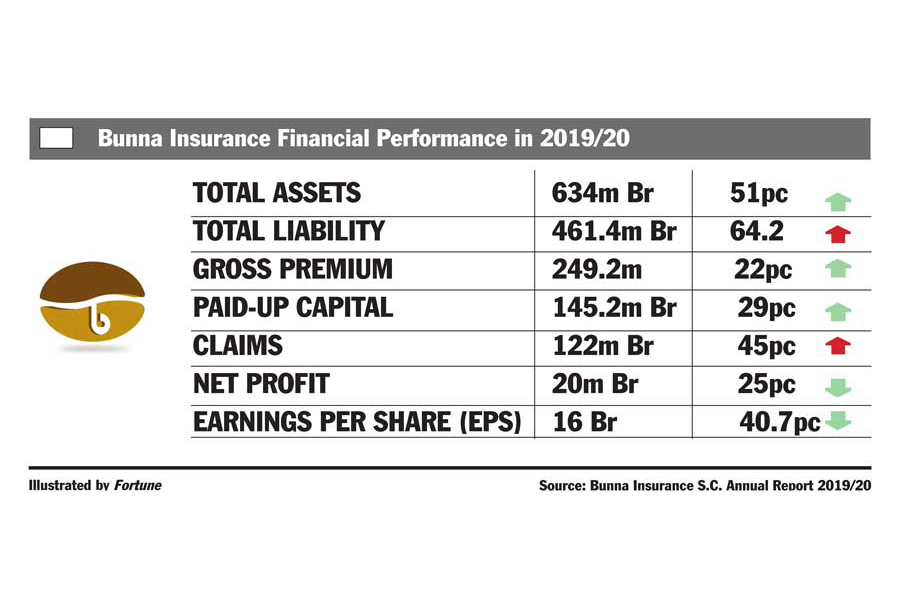
Fortune News | Dec 11,2021
The National Bank of Ethiopia (NBE) will introduce a new policy that establishes a benchmark for lending and deposit interest rates that reflects the real value of money based on inflation.
Drafted by the NBE and expected to be tabled to the Bank's board in September, the policy will reverse the existing interest rate regime within a three-year period. The new policy is part of the Homegrown Economic Reform Agenda, the all-encompassing programme of new policy prescriptions by Prime Minister Abiy Ahmed's (PhD) administration.
The new rate will be used as an instrument to move toward a market-driven interest rate regime from the current quantitative money control, according to a source close to the case.
Currently, the time and minimum savings deposit interest rate is fixed at seven percent, while the lending rate on loans and advances is freely determined by the banks.
Until the end of the second quarter of the last fiscal year, all of the commercial banks mobilised 958.9 billion Br in deposits at an average rate of eight percent. These banks have disbursed fresh loans of 58.7 billion Br at an average lending rate of 14.3pc.
The existing lending and borrowing rates do not take the inflation rate into account, according to the source.
The average headline inflation rate during the last fiscal year stood at 19.5pc. Considering this the average lending and deposit interest rates were -5.25pc and -11.5pc, respectively, in real terms, meaning depositors are seeing an 11.5pc loss in the value of their money annually.
"This is because financial institutions don't have a price anchor to use when setting their interest rate, since there is no financial market in the country," said the source.
Banks charge higher lending interest rates, since they have huge overhead costs and a rising risk premium, according to Asfaw Alemu, president of Dashen Bank.
The central bank will primarily set the lending rate banks and financial institutions borrow from each other. In setting the benchmark interest rate, the central bank takes the inflation rate into account and determines a minimum and maximum borrowing rate. Then the deposit and borrowing interest rate will be adjusted by the banks based on the rate banks and financial institutions borrow from each other.
The rates set by the National Bank will not be binding, but the regulatory bank will intervene and play a role in keeping the rates within targets. In the case of excess liquidity, where financial institutions are ready to lend money at a lower rate, the central bank will borrow from them at the minimum rate as a move to suck excess cash from the market.
And in the scenario of a liquidity crunch where banks opt to lend money at a higher rate than the maximum limit, the central bank will intervene and approach the borrowing bank to accept a loan from the central bank at the maximum rate. This will be a form of capital injection the central bank performs during liquidity crises.
This will help the central bank to execute active monetary policy to maintain liquidity, financial and macroeconomic stability, according to the source.
Getachew Woldie (PhD), an economist with 15 years of experience based in Canada, says since the rate reflects the actual price of money, the new interest rate system will build a strong financial system.
"However, the central bank needs to make sure this policy isn't 'pulling the cart before the horse,'” said Getachew.
In the absence of a capital market, it is difficult to expect a benchmark that reflects the true cost of financial instruments, in his experience.
Beginning this September, the central bank plans to open up the secondary market in order that financial institutions can use financial instruments like bonds and equities as collateral when borrowing from each other.
And when the capital market opens up, anyone in the financial sector needs to know the value or the price of money in order to assess their financial stance, according to Getachew.
The interest rate benchmark needs to be raised if inflation is higher, and the central bank can then adjust the benchmark accordingly, which will lead banks to respond by changing their interest rate on their deposits and loans, according to Getachew.
"If the market decides the benchmark at this point," said the expert, "we would likely expect a higher interest rate band that is close to the inflation rate, which could discourage borrowing and investing."
The expert applauds the intention to use a benchmark for interest rates as monetary policy, but he argues that the introduction of a benchmark interest rate and other market mechanisms should be accompanied by structural, institutional, macroeconomic and fiscal policy reforms.
"Otherwise, its effectiveness will be in question as it hampers monetary policy transmission," he said.
On the other hand, at least one industry player has doubts about whether customers are reactive to interest rates.
"From what we observe, borrowers are more sensitive to loan maturity than the interest rate," said Asfaw of Dashen Bank. "The central bank should consider this. Since both lending and deposit rates will be competitive, we have to go back and think about our operational efficiency to be competent."
PUBLISHED ON
[ VOL
, NO
]

Fortune News | Dec 11,2021

Fortune News | Oct 30,2022

Fortune News | Apr 20,2019

Viewpoints | May 24,2025

Fortune News | Nov 29,2020

Fortune News | Jul 28,2024

Radar | Dec 19,2020

Radar | Jun 01,2019

Radar | Mar 07,2020

Radar | Sep 04,2021

Dec 22 , 2024 . By TIZITA SHEWAFERAW
Charged with transforming colossal state-owned enterprises into modern and competitiv...

Aug 18 , 2024 . By AKSAH ITALO
Although predictable Yonas Zerihun's job in the ride-hailing service is not immune to...

Jul 28 , 2024 . By TIZITA SHEWAFERAW
Unhabitual, perhaps too many, Samuel Gebreyohannes, 38, used to occasionally enjoy a couple of beers at breakfast. However, he recently swit...

Jul 13 , 2024 . By AKSAH ITALO
Investors who rely on tractors, trucks, and field vehicles for commuting, transporting commodities, and f...

Jul 5 , 2025
Six years ago, Ethiopia was the darling of international liberal commentators. A year...

Jun 28 , 2025
Meseret Damtie, the assertive auditor general, has never been shy about naming names...

Jun 21 , 2025
A well-worn adage says, “Budget is not destiny, but it is direction.” Examining t...

Jun 14 , 2025
Yet again, the Horn of Africa is bracing for trouble. A region already frayed by wars...